Key takeaways:
- Anti-war activism often stems from personal experiences of loss and a desire for peace, connecting individuals through shared stories and emotions.
- Engaging youth in activism fosters new perspectives and empowers them to advocate for peace, creating a culture of dialogue over violence.
- Building trust with young people involves active listening, creating safe spaces for expression, and maintaining consistent communication.
- Organizing inclusive community events that allow for creative expression, such as art projects, enhances participation and fosters connections among activists.
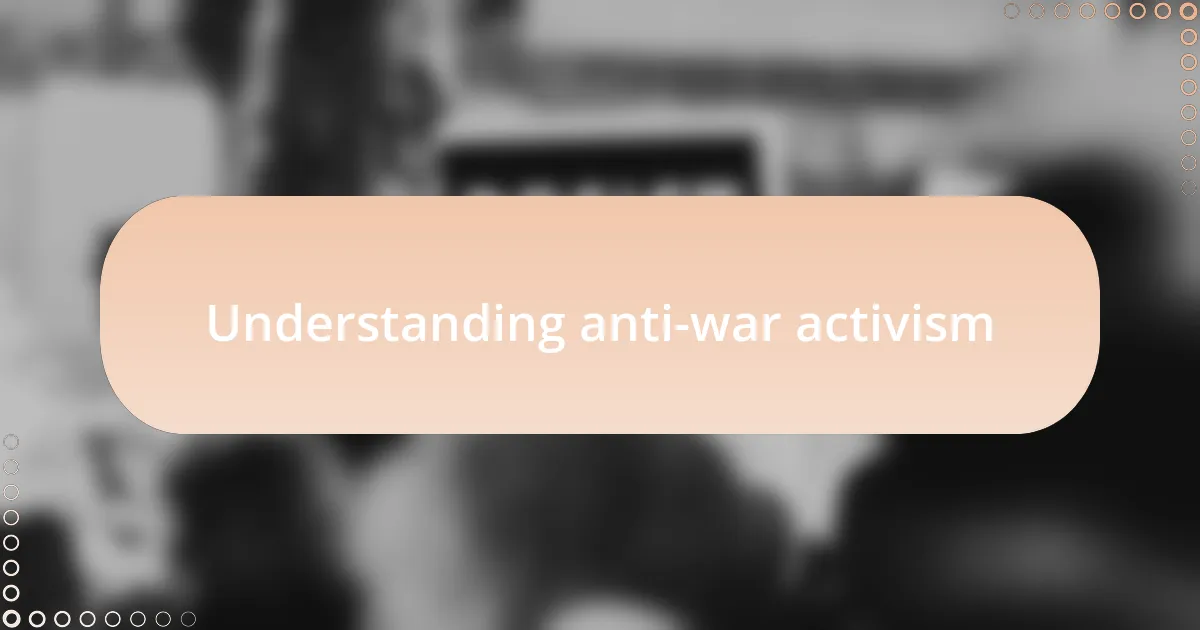
Understanding anti-war activism
Anti-war activism is rooted in a profound desire for peace and justice. I vividly recall attending a local gathering where passionate voices united, sharing stories about the impact of war on families and communities. It struck me how these personal narratives created an emotional bridge, connecting everyone in the room with a common purpose—demanding an end to violence.
When I think about the essence of anti-war activism, I often wonder: what drives individuals to take a stand against military conflict? For many, it’s not just idealism; it’s the harrowing experiences of loss that compel action. I met a young activist whose brother had been deployed and returned forever changed. Her drive to speak out was palpable, serving as a poignant reminder that activism often stems from personal heartbreak and a longing for hope.
Moreover, anti-war activism serves as a counter-narrative to the glorification of war often seen in media and politics. How can we allow our youth to grow up believing that conflict is the only solution? I’ve watched young people question this mindset, engaging critically with historical events and the consequences of military action. Their curiosity inspires me, as they challenge outdated views and advocate for a more compassionate approach to global issues.
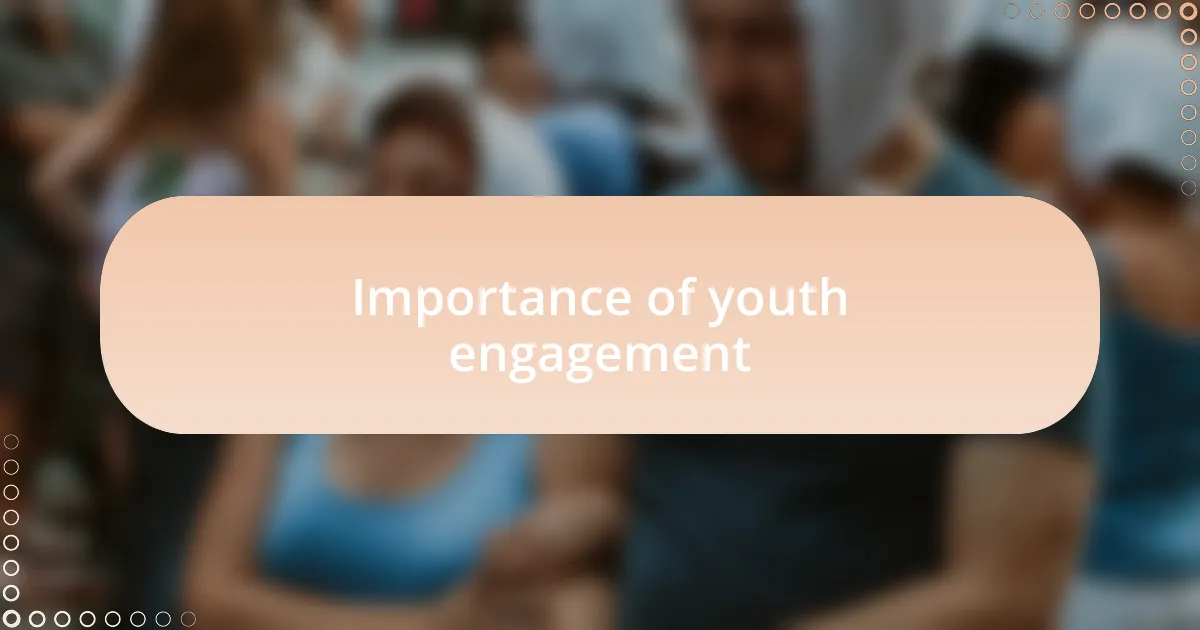
Importance of youth engagement
Engaging youth in anti-war activism is crucial because they bring fresh perspectives and boundless energy to the movement. I still remember my first community meeting where a group of high school students presented their thoughts on the impact of war. Their enthusiasm and determination left a lasting impression on me. It was eye-opening to see how they embraced the responsibility of shaping the future, illustrating how vital their engagement truly is.
When young people get involved in these movements, they don’t just advocate for peace; they help create a culture that values dialogue over violence. I’ve seen firsthand how their innovative ideas can ignite conversations that challenge the status quo. For instance, one young activist proposed a social media campaign that encouraged peers to share stories about how war has affected their lives, connecting individuals and fostering a sense of community. Isn’t it powerful to think that social media can be a platform for healing and understanding?
Moreover, youth engagement nurtures a sense of agency and empowerment among young people. I recall the pride on a teenager’s face when they organized their first awareness event about the realities of military conflict. It’s evident that when young voices are amplified, they not only educate others but also learn the strength of their own convictions. How can we expect meaningful change without involving those who will inherit the consequences of our actions?

Strategies for local outreach
To effectively reach local youth, I’ve found that building genuine partnerships with schools and community centers can make a world of difference. When I collaborated with a local high school to host a workshop on the effects of war, I was amazed by how eager the students were to engage and share their thoughts. These venues not only provide a platform but also lend credibility to the message, making it feel more relevant and accessible to young people.
Another strategy I’ve employed is using interactive and creative activities to capture their interest. For instance, during a community event, we set up a mural project where youth could express their feelings about war through art. Watching their imaginations come to life was not just gratifying; it sparked conversations that many participants carried beyond the event. Can you imagine the impact of creative expression on young minds, especially in a sometimes overwhelming world?
Lastly, leveraging social media as a tool for outreach has proven incredibly effective. I remember launching a campaign where youth were encouraged to share their thoughts about peace, using #VoicesForChange. The response was electrifying—young people from different backgrounds started to connect with one another, creating a ripple effect of discussion and action. Isn’t it fascinating how technology can bridge gaps and inspire collective advocacy?
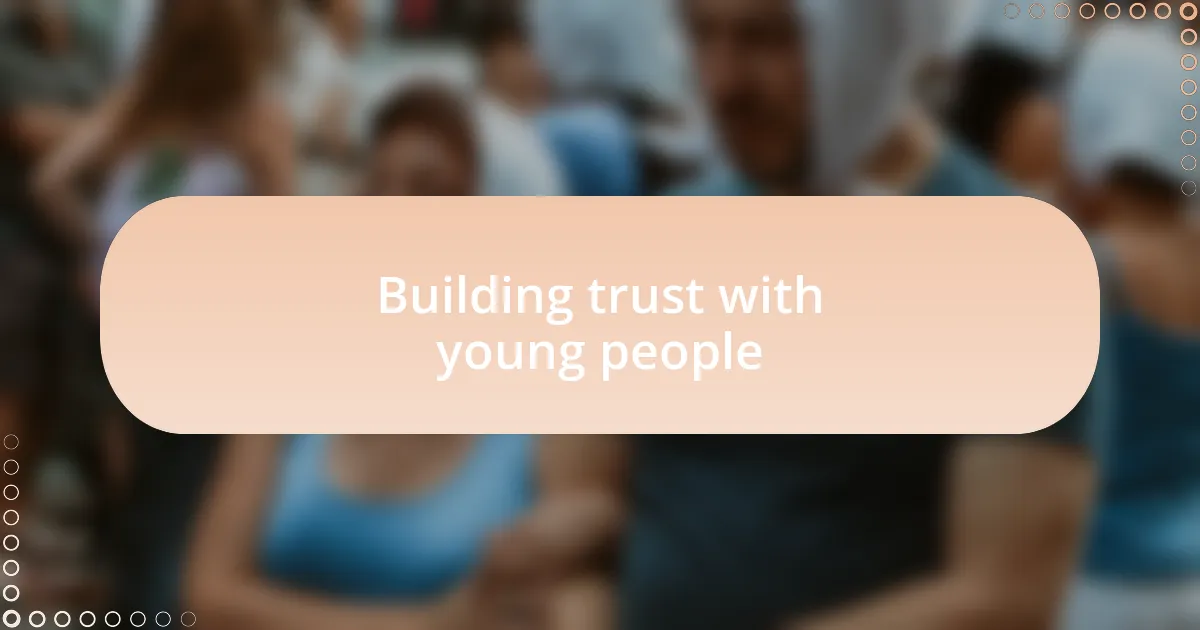
Building trust with young people
Building trust with young people requires a genuine commitment to listening and understanding their perspectives. I recall a time when I stayed after one of our workshops to hear what the students truly thought. Their feedback was invaluable—it showed me that respecting their voices made them more willing to open up about their concerns. Have you ever noticed how young people respond when they see that someone genuinely cares about their opinions?
Creating a safe space for dialogue is another vital aspect. During a community gathering, I intentionally arranged a relaxed setting where participants could share their experiences regarding war and peace. I could see the walls coming down as they realized they were in a judgment-free zone, and that sense of security encouraged them to express their vulnerabilities. Isn’t it remarkable how offering a simple space for authenticity can lead to profound connections?
Moreover, consistency in engagement helps solidify that trust. I made it a point to follow up with the youth after events, whether through emails or social media messages. I always believe that checking in shows commitment and reinforces that these relationships are meaningful. Have you ever found that small gestures can leave a lasting impact on relationships? In my experience, those simple acts of communication can truly make a difference in nurturing trust with young people.
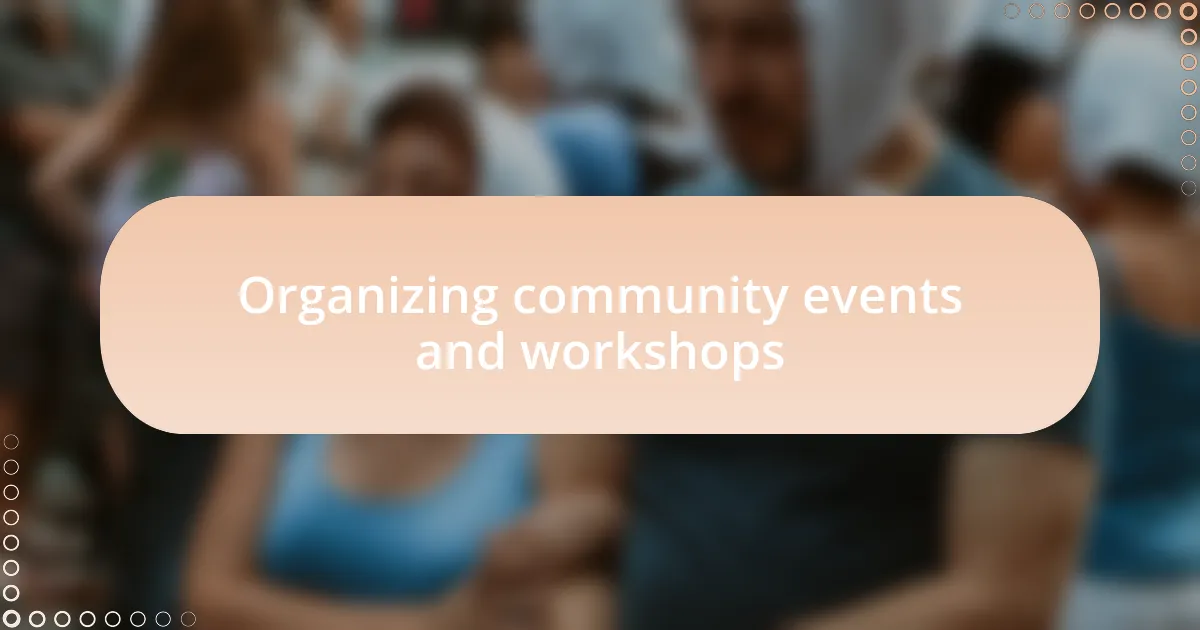
Organizing community events and workshops
Organizing community events and workshops truly breathes life into anti-war activism. I remember hosting a weekend workshop that featured local artists sharing their experiences and insights about the impact of conflict through their art. The excitement in the room was palpable; it was as if the energy shifted when we created a platform for self-expression. Have you experienced how art can evoke emotions and spark conversations that textbooks sometimes fail to capture?
I find that having hands-on activities fosters a deeper connection amongst participants. For instance, we once organized a peace-building exercise where youth collaborated to create murals depicting their visions for a world without war. Watching them transform blank canvases into powerful symbols of hope was incredibly moving. It made me reflect—how can we expect young people to engage if we don’t provide them with creative outlets to express their desires for peace?
The success of these gatherings hinges on making them inclusive and accessible. After one community event, a teen approached me, expressing how they had felt alienated from activism before but found solace in our shared discussions. This reinforced my belief that when we nurture an environment where everyone feels welcome, we not only spread awareness but also build a community of passionate advocates. Don’t you think that when we empower the voices of the youth, we cultivate a movement that is powerful and enduring?
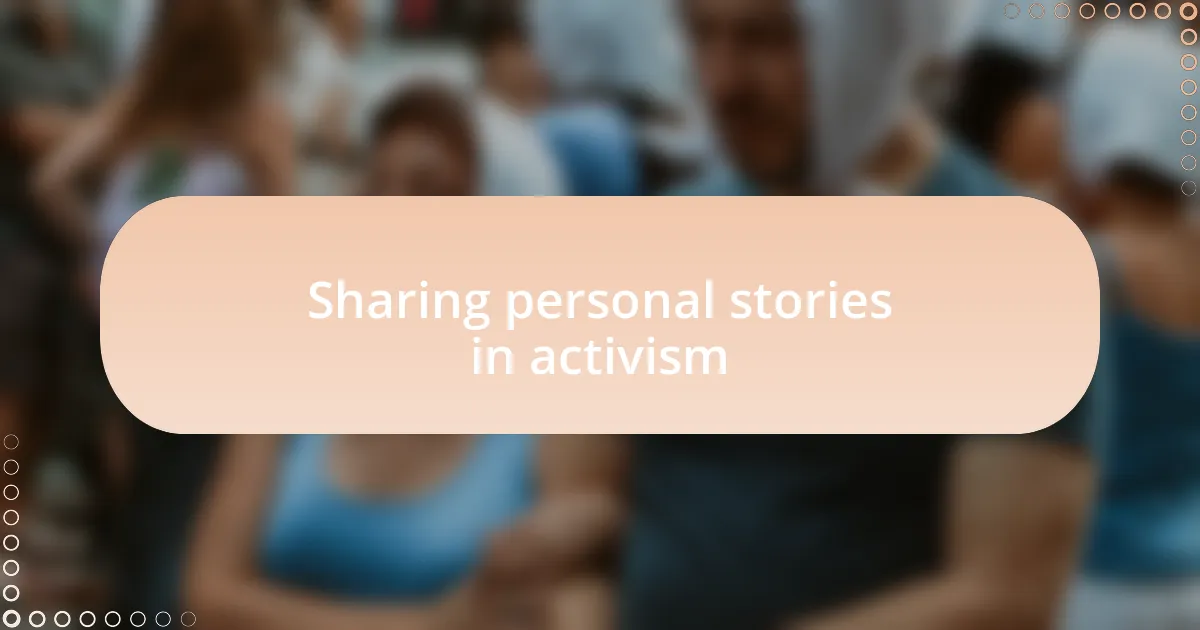
Sharing personal stories in activism
Sharing personal stories is at the heart of activism. I vividly remember a young activist named Sarah who courageously shared her experience of losing a family member to war. She spoke with such raw honesty that it resonated deeply with everyone in the room, creating an atmosphere of empathy and understanding. Isn’t it fascinating how personal narratives can bridge gaps and foster connections among diverse individuals?
When I encouraged participants to share their own experiences, I witnessed a transformative moment. A quiet boy named Sam opened up about his struggles with witnessing violence in his neighborhood. As he spoke, I could see the relief wash over him. His story empowered others to share theirs, reinforcing my belief that vulnerability is not a weakness; it’s a path to healing and unity. How often do we underestimate the power of a single voice?
In these moments, I realized that storytelling isn’t just about sharing pain; it’s also about igniting hope. After one session, a participant approached me, grateful for the space to express her fears and dreams. She told me that she had never felt more understood. Isn’t that what we all seek? A place where our voices are not just heard but valued, weaving a rich tapestry of collective experiences that can inspire change?
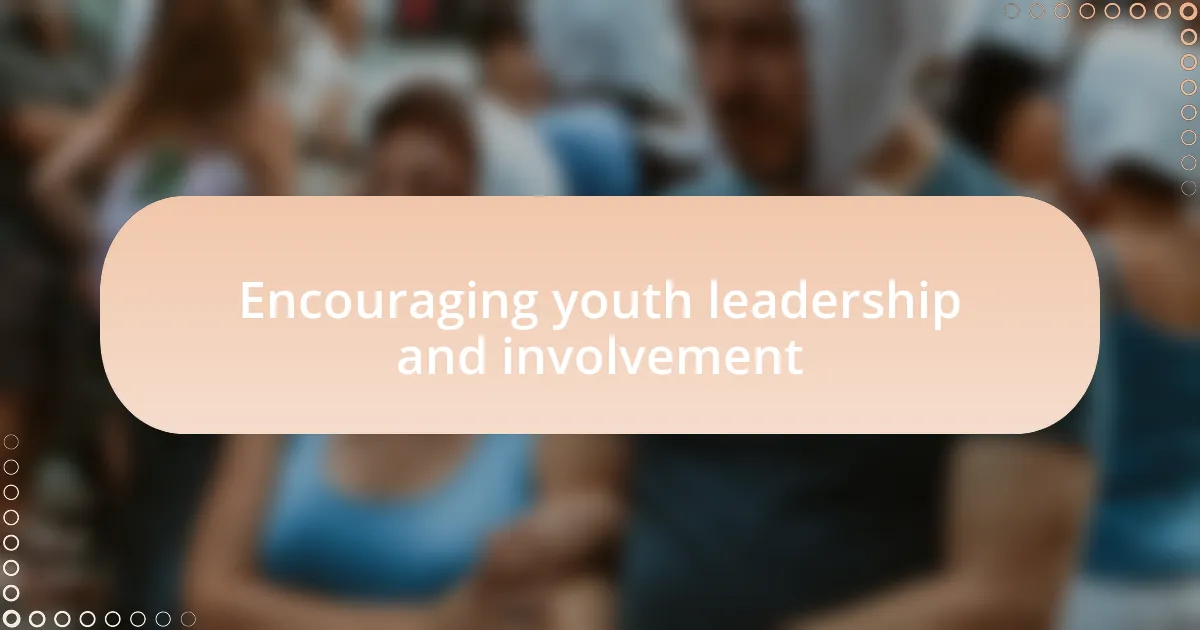
Encouraging youth leadership and involvement
Encouraging youth leadership is essential in fostering a sense of ownership within the activist community. I fondly remember the first time I facilitated a workshop focused on leadership skills. A group of enthusiastic high school students took the lead, surprising themselves with their ability to organize a local rally against war. Their excitement was palpable, and I realized that empowering young people to make decisions not only lifted their spirits but also cultivated an unexpected confidence in them.
One particular moment stands out in my memory: a shy girl named Mia stepped forward to present her ideas for the rally poster design. As she spoke, you could see her transformation; the quiet, hesitant girl turned into a passionate advocate. Her peers rallied behind her, and I was struck by how quickly they embraced her vision as their own. Doesn’t it make you wonder how often potential leaders are waiting for that nudge to emerge?
I also discovered that creating spaces for youth to express their opinions is invaluable. During a brainstorming session, I encouraged everyone to share their thoughts freely. Seeing their faces light up as they tackled hard questions about war, it became clear that when young people feel their voices matter, they are more likely to engage actively in initiatives. Isn’t it powerful to think that fostering an environment of respect and support can spark a chain reaction of involvement?